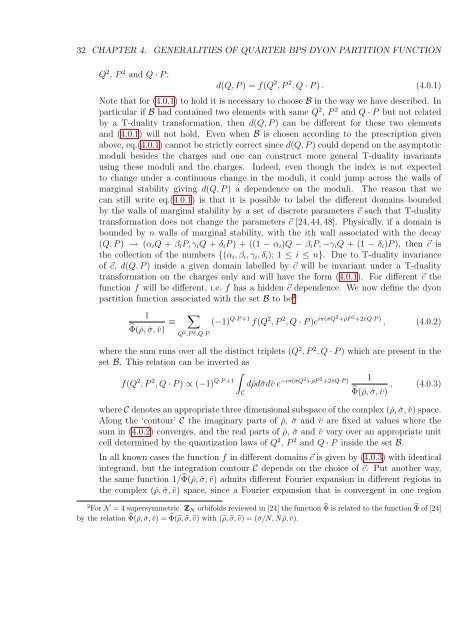PHYS08200604018 Shamik Banerjee - Homi Bhabha National ...
PHYS08200604018 Shamik Banerjee - Homi Bhabha National ...
PHYS08200604018 Shamik Banerjee - Homi Bhabha National ...
Create successful ePaper yourself
Turn your PDF publications into a flip-book with our unique Google optimized e-Paper software.
32 CHAPTER 4. GENERALITIES OF QUARTER BPS DYON PARTITION FUNCTION<br />
Q 2 , P 2 and Q · P :<br />
d(Q, P ) = f(Q 2 , P 2 , Q · P ) . (4.0.1)<br />
Note that for (4.0.1) to hold it is necessary to choose B in the way we have described. In<br />
particular if B had contained two elements with same Q 2 , P 2 and Q · P but not related<br />
by a T-duality transformation, then d(Q, P ) can be different for these two elements<br />
and (4.0.1) will not hold. Even when B is chosen according to the prescription given<br />
above, eq.(4.0.1) cannot be strictly correct since d(Q, P ) could depend on the asymptotic<br />
moduli besides the charges and one can construct more general T-duality invariants<br />
using these moduli and the charges. Indeed, even though the index is not expected<br />
to change under a continuous change in the moduli, it could jump across the walls of<br />
marginal stability giving d(Q, P ) a dependence on the moduli. The reason that we<br />
can still write eq.(4.0.1) is that it is possible to label the different domains bounded<br />
by the walls of marginal stability by a set of discrete parameters ⃗c such that T-duality<br />
transformation does not change the parameters ⃗c [24, 44, 48]. Physically, if a domain is<br />
bounded by n walls of marginal stability, with the ith wall associated with the decay<br />
(Q, P ) → (α i Q + β i P, γ i Q + δ i P ) + ((1 − α i )Q − β i P, −γ i Q + (1 − δ i )P ), then ⃗c is<br />
the collection of the numbers {(α i , β i , γ i , δ i ); 1 ≤ i ≤ n}. Due to T-duality invariance<br />
of ⃗c, d(Q, P ) inside a given domain labelled by ⃗c will be invariant under a T-duality<br />
transformation on the charges only and will have the form (4.0.1). For different ⃗c the<br />
function f will be different, ı.e. f has a hidden ⃗c dependence. We now define the dyon<br />
partition function associated with the set B to be 2<br />
1<br />
̂Φ(ˇρ, ˇσ, ˇv) ≡<br />
∑<br />
Q 2 ,P 2 ,Q·P<br />
(−1) Q·P +1 f(Q 2 , P 2 , Q · P )e iπ(ˇσQ2 +ˇρP 2 +2ˇvQ·P ) , (4.0.2)<br />
where the sum runs over all the distinct triplets (Q 2 , P 2 , Q · P ) which are present in the<br />
set B. This relation can be inverted as<br />
∫<br />
f(Q 2 , P 2 , Q · P ) ∝ (−1) Q·P +1 dˇρdˇσdˇv e −iπ(ˇσQ2 +ˇρP 2 +2ˇvQ·P ) 1<br />
̂Φ(ˇρ, ˇσ, ˇv) , (4.0.3)<br />
C<br />
where C denotes an appropriate three dimensional subspace of the complex (ˇρ, ˇσ, ˇv) space.<br />
Along the ‘contour’ C the imaginary parts of ˇρ, ˇσ and ˇv are fixed at values where the<br />
sum in (4.0.2) converges, and the real parts of ˇρ, ˇσ and ˇv vary over an appropriate unit<br />
cell determined by the quantization laws of Q 2 , P 2 and Q · P inside the set B.<br />
In all known cases the function f in different domains ⃗c is given by (4.0.3) with identical<br />
integrand, but the integration contour C depends on the choice of ⃗c. Put another way,<br />
the same function 1/̂Φ(ˇρ, ˇσ, ˇv) admits different Fourier expansion in different regions in<br />
the complex (ˇρ, ˇσ, ˇv) space, since a Fourier expansion that is convergent in one region<br />
2 For N = 4 supersymmetric Z N orbifolds reviewed in [24] the function ̂Φ is related to the function ˜Φ of [24]<br />
by the relation ̂Φ(ˇρ, ˇσ, ˇv) = ˜Φ(˜ρ, ˜σ, ṽ) with (˜ρ, ˜σ, ṽ) = (ˇσ/N, N ˇρ, ˇv).

















